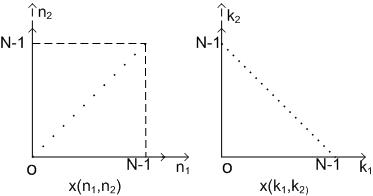Example 1: (1's on diagonal of square)
Consider a spatial sequence of finite extent  , as illustrated in the left-hand side of Figure (4.3). , as illustrated in the left-hand side of Figure (4.3).

Figure(4.3) |
Proceeding to take the DFT, we obtain for  : :



and, of course,  elsewhere, as illustrated on the right-hand side of Figure (4.3 ). Note that this is analogous to the case of the continuous-parameter Fourier transform of an impulse line. This ideal result occurs only when the line is exactly at elsewhere, as illustrated on the right-hand side of Figure (4.3 ). Note that this is analogous to the case of the continuous-parameter Fourier transform of an impulse line. This ideal result occurs only when the line is exactly at  and the DFT size is square. For other angles, we get a and the DFT size is square. For other angles, we get a   in k type of approximation that tends to the impulse line solution more and more as N grows large without bound. Of course, as was true for the continuous-space (parameter) Fourier transform, the line of impulses in frequency is perpendicular or at 900 to the impulse line in space. in k type of approximation that tends to the impulse line solution more and more as N grows large without bound. Of course, as was true for the continuous-space (parameter) Fourier transform, the line of impulses in frequency is perpendicular or at 900 to the impulse line in space.
|